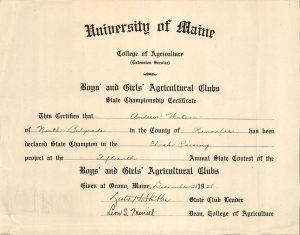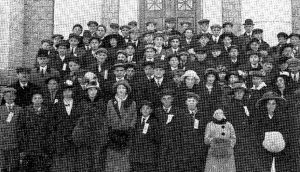State 4-H Championship Certificate
 The certificate in our collection was awarded in 1928 during the 15th Annual State 4-H Contest to Andrew Watson, a Kennebec County 4-H’er from North Belgrade, for his work in poultry, noted on certificate as “Chick Raising”. This was, in fact, Watson’s SECOND Chick Raising Champion certificate; he would get two more making four in a row, 1927 through 1930! In 1931, Watson was one of four Maine 4-H Members to receive the honor of representing Maine 4-H at the 5th National 4-H Camp/Conference held in Washington, D.C. Watson later served as a Navy LTjg during WWII and after the war became a Marketing Specialist with the Maine Department of Agriculture. Andrew Watson died at age 91 in Largo, Florida on January 29, 2004.
The certificate in our collection was awarded in 1928 during the 15th Annual State 4-H Contest to Andrew Watson, a Kennebec County 4-H’er from North Belgrade, for his work in poultry, noted on certificate as “Chick Raising”. This was, in fact, Watson’s SECOND Chick Raising Champion certificate; he would get two more making four in a row, 1927 through 1930! In 1931, Watson was one of four Maine 4-H Members to receive the honor of representing Maine 4-H at the 5th National 4-H Camp/Conference held in Washington, D.C. Watson later served as a Navy LTjg during WWII and after the war became a Marketing Specialist with the Maine Department of Agriculture. Andrew Watson died at age 91 in Largo, Florida on January 29, 2004.
The first State Contest was held December 21-23, 1914 on the UMaine Orono campus. Emily Morse of Cherryfield was named the overall state winner making her Maine’s first state champion, although the actual title “Champion” was not used until 1915. Her project was Gardening and Canning. The 1915 Gardening and Canning Champion title went to a 4-H’er from Aroostook County. Emily earned the Canning Champion title in 1916 and 1917 and just missed being chosen in 1918. Her achievements brought much needed attention to how effective and educational Club Work was for both community and child.
 In this photo we see the 4‑H’ers who attended that first State 4-H Contest in 1914. They are standing on the front steps of the Carnegie Library on the UMaine Orono campus. Emily Morse is the short girl in the front row, third from the right, wearing the light colored coat with the two big, black buttons.
In this photo we see the 4‑H’ers who attended that first State 4-H Contest in 1914. They are standing on the front steps of the Carnegie Library on the UMaine Orono campus. Emily Morse is the short girl in the front row, third from the right, wearing the light colored coat with the two big, black buttons.
In 1915, although Emily was awarded a score of 100 on her 10 exhibited jars of fruits and vegetables (worth 20% of the score) and her story was deemed to be the best submitted (worth 20%), the title of Canning and Gardening Champion went to Aroostook County’s 12 year old Crystal Waddell of Mapleton. One of the selling points for involvement in early club work was that money could be made through the project work. Crystal reported a 1915 profit (worth 30%) of $39.03 on her 10th acre of beets after covering her expenses including 20 cents an hour for her own labor. “Production” was the final 30% of the score.
According to a story on page 5 of the December 30, 1916 edition of the Bar Harbor Times, Canning Champion Emily was joined by 1916 Champions Alma Davis, Machias, Poultry; Dorothy Shackford, Ellsworth, Pig Raising; Milfred Blackstone, Perham, Potato Raising; and Hilda Sullivan, Orono, Gardening.
The 16th Annual State 4-H Contest, held in 1929, is regarded as one of the best ever held. That year Andrew Watson was named Chick Raising Champion for the third year in a row. His fellow 1929 champions were Helen Goodwin, Shapleigh, Beans; Margaret Knightly, Norway, Canning; Gilbert Cox, New Sharon, Gardening; Lucinda Rich, Charleston, Cooking and Housekeeping; Wayne Rich, Charleston, Pig Raising and Potato Raising; Linwood Chase, Hampden, Sweet Corn; Wilson Luftkin, Levant, Dairy; Hayden Rogers, West Bath, Poultry Management; Clarinda Davis, Buxton, Room Improvement; and Helen Clements, Monroe, Sewing. Obviously, the number of champions had increased through the years.
As understanding of the science of youth development progressed, however, less emphasis was placed on head to head competitions and more emphasis was given to recognizing excellence of one’s own efforts. Traditional State Championships were discontinued in 1939, replaced by recognition being given to 4‑H’ers who excelled in 4-H regardless of their projects. By 1941 the only “state championships” awarded were those supported by national donors, the process primarily serving as a means of identifying delegates for national 4-H experiences. Eleven such project-specific “champions” were named in 1941, six members were designated to attend National 4-H Club Congress in Chicago and two delegates were designated to attend the National Dairy Show in Memphis, TN; while two others received gold watches and one received a gold medal.
In a report on Extension in Maine from 1910 to 1950, Clarence Day, Extension Editor Emeritus, wrote in 1957, “…during the 1930s 4-H club work became mature. …Club Work had won a sure place in the educational system of the nation…. Extension Service would continue to give administrative guidance, while success or failure (of club work) would…rest with the people themselves.”
For more information on Maine’s 4-H Champions, visit the 4-H Fix blog post “Champions!”
